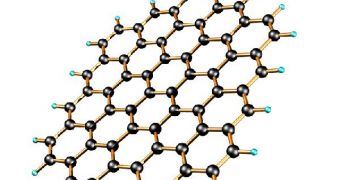Graphene, the one-atom-thick sheet of carbon atoms that was discovered in 2004 at the University of Manchester, is the most avidly researched material today in the field of condensed-matter physics. Because electrons flow in a very peculiar way through it, experts believe it may constitute the replacement of choice for silicon, the main semiconductor in computer chips today. Just recently, researchers have discovered a new peculiarity in the material, when they have demonstrated the fractional quantum Hall Effect in it, ScienceNow reports.
The scientists essentially proved that, within graphene, electrons could team up in pairs, which then behaved as if they were particles with only a fraction of the original electrons' mass. The FQHE is an embellishment of an esoteric phenomenon known as the Hall Effect, which was first established in 1879.
The discovery of the QHE won the Nobel Prize in physics in 1985. As a voltage is applied to a metal bar, electrons within it flow naturally from one end to the other. If a magnetic field is applied vertically to the bar, then the electrons will be subjected to a sideways shove, which will force them to conglomerate on one side of the bar.
This means that a voltage is also developed along the width of the bar, and also that the sideways voltage increases proportionally to the intensity of the magnetic field. When applying the model to an extremely thin bar of superconducting material, the electrons can only flow through very few quantum channels, which close off one by one as the intensity of the magnetic field increases.
If the semiconductor is cold and has a high degree of purity, then “quasiparticles” are formed from electrons. These elements only carry a fraction of their components' masses, such as, for instance, one third. This is the FQHE, which won the Nobel Prize in Physics in 1988.
The thing about graphene is that, within it, electrons do not necessarily move as large particles with mass, but more like massless, light particles. This made physicists wonder if the FQHE was applicable to the new material, and if it was worth investigating it further on.
Rutgers University expert Eva Andrei and her team managed to demonstrate electron pairs in quasiparticles for the first time in graphene, ending the debate and proving previous investigations wrong. “It's absolutely convincing. It definitely proves it's reasonable to study electron-electron interactions in graphene,” University of Manchester physicist Kostya Novoselov, who has not been part of the study, says.
Andrei adds that the team will continue to analyze graphene from this perspective, in the hope that even more exotic and weird particles or pairing methods will be uncovered.

 14 DAY TRIAL //
14 DAY TRIAL //